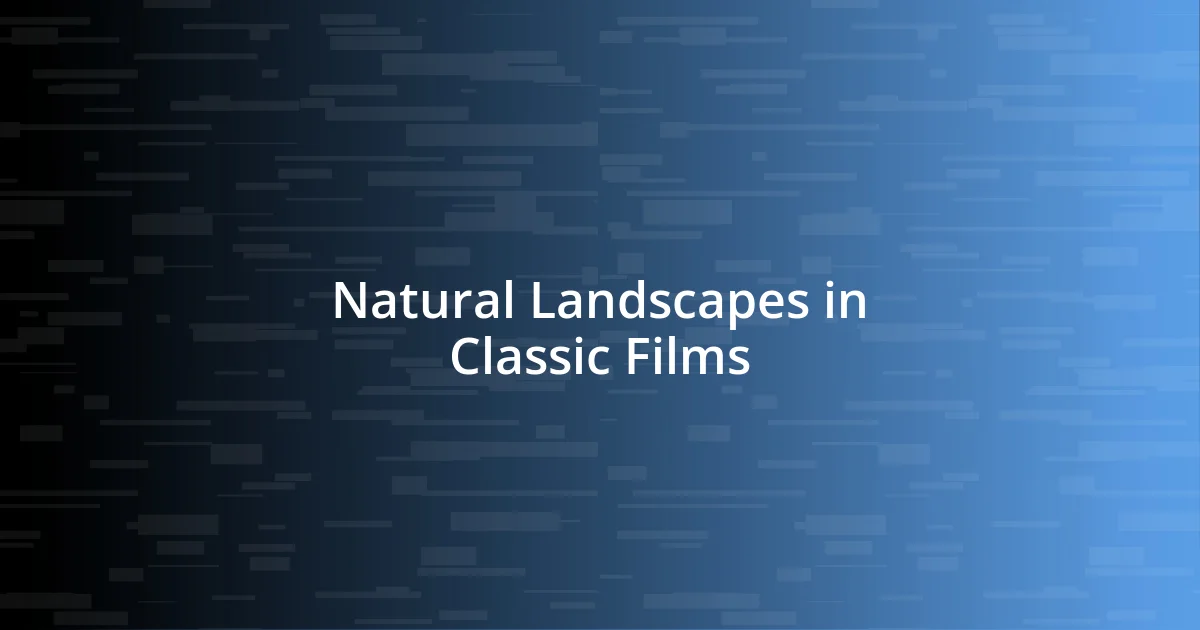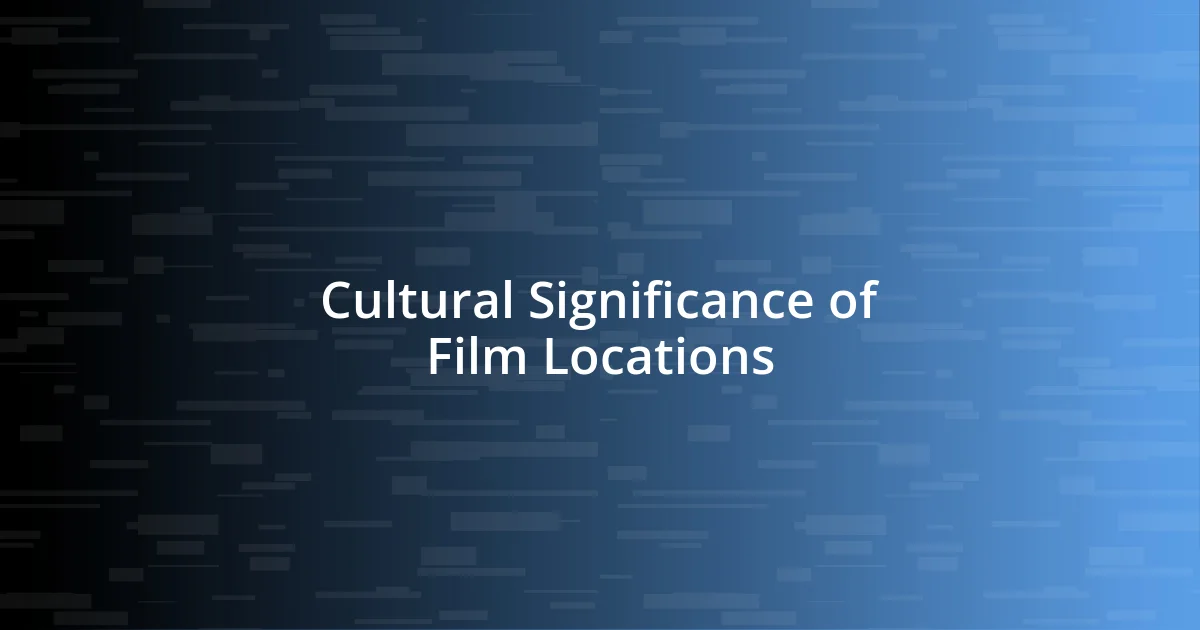Key takeaways:
- Cinematic locations significantly enhance storytelling by influencing mood, evoking emotions, and creating memorable connections for viewers.
- Key criteria for selecting locations include their atmospheric influence, emotional resonance, and authenticity, which deepen the narrative experience.
- Iconic films are often inseparable from their locations, embodying themes of love, struggle, and dreams, and leaving lasting impressions on audiences.

Overview of Cinematic Locations
Cinematic locations are more than just backdrops; they breathe life into stories and shape the emotions we feel while watching. I remember the first time I saw the vast, haunting landscapes of Monument Valley in a Western film. The sheer emptiness engulfed me, making me ponder how a setting can evoke feelings of solitude and adventure all at once.
Every classic film uses its location to enhance the narrative, often transforming ordinary places into iconic landmarks. When I think of the sun-drenched streets of San Francisco in “Vertigo,” I’m reminded of how that vibrant cityscape mirrored the obsession and turmoil of the characters. It makes me wonder: how would the film’s impact shift if those scenes were shot elsewhere?
I find it fascinating that some locations have become so intertwined with their respective films that visiting them often feels like stepping into a different world. For instance, standing in front of the charming café from “Amélie” in Montmartre, I felt an overwhelming sense of nostalgia and whimsy, as if the magic of the film lingered in the air. It’s a testament to the power of setting in shaping not only our viewing experience but also our personal connections to films.

Criteria for Choosing Locations
Choosing cinematic locations is a nuanced process that significantly impacts the storytelling experience. I often think about how a location can embody the essence of a character or even serve as a silent participant in the film. For instance, the chilling atmosphere of the Bates Motel in “Psycho” is not just a setting but almost a character itself—infusing each scene with a sense of foreboding that is hard to shake off.
Another important criterion is the emotional resonance a location can evoke. Take the rolling hills of Tuscany in “The English Patient” as an example. Watching those breathtaking landscapes gives me a sense of longing and nostalgia, amplifying the film’s themes of love and loss. It’s intriguing how specific places can transport us back to emotions we’ve felt, isn’t it? When filmmakers choose locations with rich histories or emotional backstories, it enhances the narrative depth.
Finally, the accessibility and authenticity of a location play a crucial role in its selection. Filming in real, often underappreciated places can lend an air of authenticity that resonates with audiences. I still recall my visit to the quaint bookstore in “Notting Hill.” It felt surreal to walk the same streets as my favorite characters, which mingled reality with the magic of cinema. This blending of actual locations with fictional stories deepens our connection to films, making them more memorable.
| Criteria | Description |
|---|---|
| Atmospheric Influence | How the location affects the film’s mood and tone. |
| Emotional Resonance | The emotional connections evoked by the setting. |
| Accessibility and Authenticity | How realistic and reachable the locations are for the audience. |

Famous Classic Films and Locations
Some classic films have become inseparable from their iconic locations, making them almost characters themselves. For instance, the charming canals of Venice featured in “Roman Holiday” add a layer of magic that reflects the film’s themes of freedom and romance. I can still picture Audrey Hepburn’s effortless grace against that stunning backdrop, and it makes me wish I could have shared in her adventure.
Here’s a quick list of some other classic films and their unforgettable locations:
- “Casablanca” (1942) – Rick’s Café in Casablanca, Morocco, captures the essence of wartime romance.
- “Gone with the Wind” (1939) – Tara Plantation symbolizes both beauty and the tumult of the South during the Civil War.
- “Breakfast at Tiffany’s” (1961) – Tiffany & Co. in New York City, a dreamlike setting that truly embodies glamour and possibility.
- “The Wizard of Oz” (1939) – The Yellow Brick Road in Kansas, leading to the enchanting Emerald City, which evokes childhood wonder.
- “North by Northwest” (1959) – Mount Rushmore serves as a thrilling backdrop for one of cinema’s most famous chase scenes.
These locations not only elevate the story but leave indelible marks on our memories, reminding us of the powerful connection between film and place.

Iconic Urban Settings in Classics
When I think about iconic urban settings in classic films, New York City often comes to mind. Just imagine walking down the streets that Holly Golightly wandered in “Breakfast at Tiffany’s.” The bright lights and bustling atmosphere resonate with a sense of dreams and aspirations. I remember visiting the famous Tiffany’s store, standing there among the glimmering jewels, feeling as though I had stepped into a cinematic dream myself. It’s interesting how certain locations can evoke personal memories tied to a beloved film, isn’t it?
Another unforgettable urban setting is the romantic streets of Paris in “An American in Paris.” The vibrant art scenes and picturesque cafes create an enchanting backdrop that captures the essence of love and creativity. Each time I see Gene Kelly dancing along the Seine, I can’t help but feel a surge of joy. It’s as if the city itself is alive, encouraging us to embrace spontaneity and artistry. Wouldn’t it be wonderful to experience a city that embodies such passion?
Finally, the haunting streets of Berlin in “Metropolis” leave a lasting impact on my cinematic journey. The film’s expressionist architecture reflects the societal struggles of its time, creating an eerie yet captivating atmosphere. I vividly recall my first viewing; the city felt less like a mere setting and more like a poignant commentary on humanity itself. Urban environments have a unique ability to shape our understanding of characters, don’t they? Each classic reveals a layer of emotional depth and complexity through its chosen location, allowing us to connect on a much deeper level.

Natural Landscapes in Classic Films
I’ve always been captivated by the breathtaking natural landscapes featured in classic films. Take “The Sound of Music,” for instance. The sweeping vistas of the Austrian Alps reflect both beauty and a sense of liberation that resonates deeply with me. Every time I see Maria spinning on that hill, I feel a longing to escape to the mountains, to dance in the meadow, and to find my own tune. Isn’t it remarkable how a simple landscape can inspire such joy?
Another incredible example is the rugged coastlines of “From Here to Eternity.” The dramatic beach scenes are not just stunning; they symbolize love and vulnerability against the backdrop of impending conflict. I remember watching that film for the first time, my heart racing as the waves crashed against the shore, mingling with the deep emotions of the characters. What is it about water that often mirrors our own emotional tides? Those natural elements truly enhance the storytelling.
Then we have the hauntingly beautiful sunsets in “The Grapes of Wrath.” The open plains of Oklahoma, combined with those vibrant colors, evoke a deep sense of struggle and hope. They remind me of those quiet moments when the sky transforms into a canvas of dreams. Can you recall a sunset that took your breath away? It’s fascinating how classic films use natural landscapes to communicate complex feelings, shaping our perceptions of the characters’ journeys.

Cultural Significance of Film Locations
When considering the cultural significance of film locations, I’m often struck by how these settings become characters in their own right. For instance, the streets of San Francisco in “Vertigo” are not just a backdrop but a symbol of obsession and entrapment. I recall watching the film, feeling my heart race as the camera panned over those steep hills. It made me reflect on how locations can shape narratives—evoking emotions we didn’t even know were buried within us. Isn’t it fascinating how a place can resonate so deeply with the audience?
The stunning architecture of Casablanca in, well, “Casablanca” is another prime example. The film’s setting perfectly captures the essence of lost love and hope during difficult times. I remember my own travels to Morocco, walking through vibrant markets while the haunting melody of “As Time Goes By” played in my mind. Those locations symbolize resilience and a sense of longing that transcend their frames. They remind us of a past filled with stories, evoking nostalgia and connection to history. How often do we find ourselves drawn to places that remind us of the stories we’ve loved?
Moreover, consider the bleak landscapes of “The Wizard of Oz,” where Kansas represents the mundane, while the vibrant Technicolor of Oz symbolizes dreams and escape. I can vividly picture myself as a child watching Dorothy’s journey unfold; it made me yearn for adventure beyond my own backyard. The contrast between those two worlds highlights our desire to break free from the ordinary. Each locale tells a tale of human experience, urging us to explore, to dream, and perhaps to seek our own version of ‘somewhere over the rainbow.’ Do you have a location that sparks a yearning for something greater?














